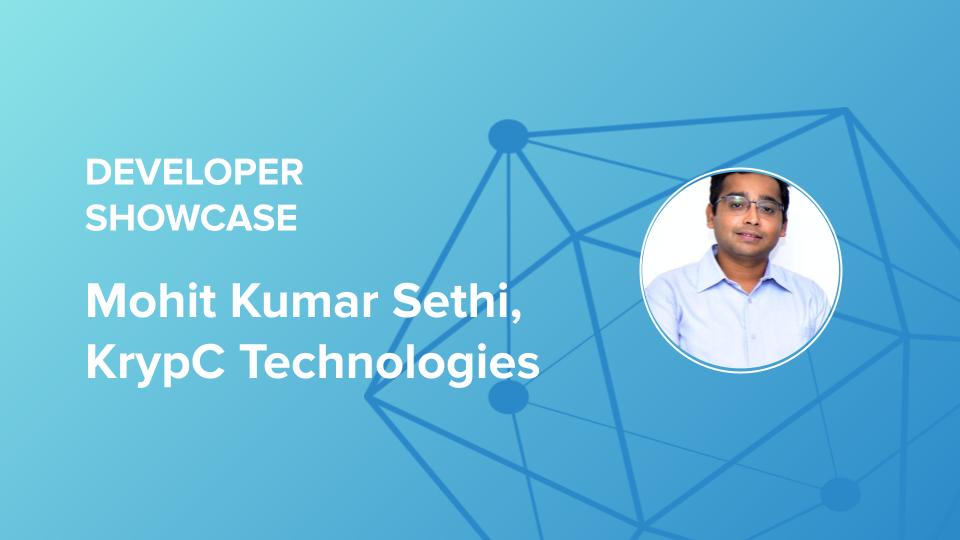Developer Showcase Series: Mohit Kumar Sethi, KrypC Technologies

Back to our Developer Showcase Series to learn what developers in the real world are doing with Hyperledger technologies. Next up is Mohit Kumar Sethi, Enterprise Blockchain Engineer at KrypC Technologies.
Give a bit of background on what you’re working on and how you got into blockchain
At KrypC, I work on the development of KrypCore, which is our core offering. KrypCore allows organizations to accelerate their blockchain journey using Hyperledger Fabric. It abstracts complexities of deployment, governance and chaincode management and lets users focus on the business logic. We have used KrypCore to design and deploy a variety of use cases in production ranging from supply chain, provenance, trading and micro finance.
I have also had the opportunity to work in the field of smart cards, cryptography and payments. The application focused on secure messaging, digital signatures and immutability. Bitcoin and cryptocurrency were natural areas of interest as they related to cryptographic security and payments. We did a deep technical study of Bitcoin and realized how it has stitched existing cryptographic concepts and P2P networks to form an immutable decentralized token network. The challenge we tackled was how to the advantage of immutability and autonomous contracts to the enterprise business and hide the complexity of the protocol.
What Hyperledger frameworks or tools are you using in your projects? Any new developments to share? Can you sum up your experience with Hyperledger?
We use Hyperledger Fabric as the primary DLT. We use the combination of Hyperledger Fabric and Hyperledger Fabric SDK Go as part of our internal SDK to develop all Fabric-based projects.
What do you think is most important for Hyperledger to focus on in the next year?
From a Hyperledger Fabric point of view, I think: Zero Knowledge Proof (ZKP) & Privacy Enhancements. Hyperledger Fabric has evolved a long way since version 1.0. PDC (Private Data Collection) provided solutions to many of the privacy and compliance needs. However, further strengthening of privacy can be achieved using ZKP or some related privacy preserving techniques.
The introduction of implicit PDC policies have simplified adoption and management of PDCs in large member networks. The current features, capabilities and design approach for PDC are well suited for most use cases. However, there are scenarios where privacy demands are not just limited to the visibility of the data but demands privacy on actions. For example:
- The ability to hide the fact that selective members operated on some private key & value. The collection ids are visible in the read/write sets. This enables other members to be aware of the fact that some private information is processed between owners of collection members present in read/write sets.
What advice would you offer other technologists or developers interested in getting started working on blockchain?
There are numerous online materials available on blockchain. It is good to start with reading the basics like how blocks are related to each other and the concept of digital signature. The next step would be to go deep on Bitcoin and Ethereum white papers. Hyperledger Fabric provides very good documentation and examples. The documentation covers both developers and technologists.
Apart from knowledge of the technology, it is equally important to understand the suitability of the technology to solve a problem. Lets remember blockchain is not a replacement for traditional databases. Use cases should be evaluated for applicability of blockchain. There are multiple blockchain protocols each suiting different applications. For example: Hyperledger Fabric provides tremendous capabilities of enterprise networks where permission and governance are managed by the private consortium. However, if we need publicly auditable immutable trust records or exchangeable tokens, Ethereum is preferable. Complex networks can use a combination of protocols in public and private domains to suit multiple needs like scale, privacy, tokenized assets and immutability.
What’s the one issue or problem you hope blockchain can solve?
Fake currency
Where do you hope to see Hyperledger and/or blockchain in five years?
Adoption in the field of voting, e-governance. Blockchains would provide the required secure sharing and discovery platform for IoT networks.
What is the best piece of developer advice you’ve ever received?
Try to keep the functions/methods small and reusable.
What technology could you not live without?
Docker/Containerization! It is not going to be easy to manage local developments or deployments.
